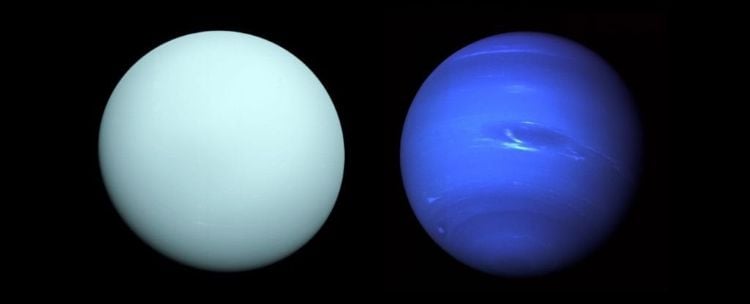What if our understanding of Uranus and Neptune’s compositions have been wrong, specifically regarding their classifications as “ice giants”? This is what a recent study accepted for publication in *Astronomy & Astrophysics* hopes to address as a team of researchers from the University of Zurich investigated the interior structures of Uranus and Neptune. This study has the potential to help scientists not only better understand the formation and evolution of Uranus and Neptune but could also provide key insights into Jupiter and Saturn, and gaseous exoplanets, too.
For the study, the researchers analyzed a series of computer models designed to simulate the interiors of Uranus and Neptune based on current planetary data for each, including mass, equatorial radius, pressure, reference radius, rotation period, and gravitational moments. Combining this with new algorithms, the researchers wanted to ascertain a better understanding of the interiors of both Uranus and Neptune and planetary interiors, overall. While a planet’s equatorial radius is measured from the center of the planet to its equator, this works best for solid surfaces. Since Uranus and Neptune are gas planets, their equatorial radii are measured from the center to the edge of their gaseous atmospheres. Therefore, reference radii are used for gas planets like Uranus and Neptune for modeling purposes.
In the end, the researchers found interiors compositions of Uranus and Neptune are dominated by rock and water. Specifically, their rock-to-water ratios list Uranus having a larger ratio than Neptune by almost 10 times. As a result, the researchers allude to changing the longstanding classification of Uranus and Neptune being “ice giants” as being “rock giants”.
The study concludes by stating, “With the potential for future dedicated missions to Uranus and Neptune, our method also provides a flexible and unbiased tool for interpreting forthcoming data. Ultimately, the interiors of Uranus and Neptune remain enigmatic, not because they are beyond reach, but because the data required to resolve their secrets are still out of grasp. Until then, only a plurality of models, not a singular one, can capture the full extent of possibilities for their hidden depths.”
The only human-made spacecraft to have visited Uranus and Neptune is NASA’s Voyager 2, which occurred in January 1986 and August 1989, respectively. Despite these two brief flybys, Voyager 2 obtained a wealth of knowledge about both gas giants, including data regarding their atmospheres, interiors compositions, moons, and rotational properties. For Uranus, Voyager 2 discovered two new rings and 10 moons, which provided scientists with new insights into rocky planetary body formation and evolution. Voyager 2 was the first to discover that Uranus rotated on its side but still exhibited a magnetic field like Earth’s. The planet’s sunlit pole was found to emit ultraviolet radiation and even emit a peculiar glow. For Neptune, Voyager 2 measured the planet’s mass while also observing auroras that were weaker than on Earth since Neptune’s magnetic field was offset from the center of the planet.
Future planned missions to Uranus have either only been proposed or are still in the planning stages, the latter of which is China’s Tianwen-4 spacecraft, and with NASA considering the Uranus Orbiter and Probe mission. For Neptune, more than a half-dozen missions have been proposed, most notably NASA’s Neptune Odyssey mission. One of the primary reasons for not sending another spacecraft to Uranus or Neptune is the enormous distance and time it would take to reach them. Voyager 2 circumvented this by taking advantage of a planetary alignment that only happens every 175 years, enabling Voyager 2 and its twin spacecraft, Voyager 1, to visit all the outer planets in a fraction of the time.
Uranus and Neptune have long been designated as “ice giants” due to their higher water-to-rock ratio than Jupiter and Saturn, which are primarily comprised of hydrogen and helium and are appropriately designated as “gas giants”. Therefore, studies like this not only help scientists understand the formation and evolution of gas giants within our solar system but also shed light on the formation and evolution of gas giant exoplanets, too.
What new discoveries about the interiors of Uranus and Neptune will researchers make in the coming years and decades? Only time will tell, and this is why we science!
As always, keep doing science & keep looking up!

